- Clone
- NKI-SAM-1 (See other available formats)
- Regulatory Status
- RUO
- Other Names
- α5 integrin, VLA-5 α chain, Integrin α5 chain, ITGA5
- Isotype
- Mouse IgG2b, κ
- Ave. Rating
- Submit a Review
- Product Citations
- publications
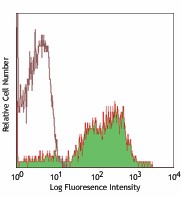
-

Human peripheral blood lymphocytes stained with NKI-Sam-1 PE
| Cat # | Size | Price | Quantity Check Availability | Save | ||
|---|---|---|---|---|---|---|
| 328009 | 25 tests | 108€ | ||||
| 328010 | 100 tests | 234€ | ||||
CD49e is a type I integral membrane glycoprotein, known as α5 integrin, VLA-5 α chain. It forms noncovalent heterodimer with integrin β1 (CD29). CD49e contains two disulfide-linked subunits of 135 kD and 24 kD, and is mainly expressed on thymocytes, activated lymphocytes, endothelial cells, osteoblasts, melanoma, and some myeloid leukemia cells. CD49e/CD29 complex binds to fibronection and neural adhesion molecule L1. It mediates monocytes migration, involves in the regulation of cells survival and apoptosis, and co-stimulates T cell activation.
Product DetailsProduct Details
- Verified Reactivity
- Human, Cynomolgus, Rhesus
- Reported Reactivity
- African Green, Baboon
- Antibody Type
- Monoclonal
- Host Species
- Mouse
- Immunogen
- U937 cells
- Formulation
- Phosphate-buffered solution, pH 7.2, containing 0.09% sodium azide and BSA (origin USA)
- Preparation
- The antibody was purified by affinity chromatography, and conjugated with PE under optimal conditions.
- Concentration
- Lot-specific (to obtain lot-specific concentration and expiration, please enter the lot number in our Certificate of Analysis online tool.)
- Storage & Handling
- The antibody solution should be stored undiluted between 2°C and 8°C, and protected from prolonged exposure to light. Do not freeze.
- Application
-
FC - Quality tested
- Recommended Usage
-
Each lot of this antibody is quality control tested by immunofluorescent staining with flow cytometric analysis. For flow cytometric staining, the suggested use of this reagent is 5 µl per million cells in 100 µl staining volume or 5 µl per 100 µl of whole blood.
- Excitation Laser
-
Blue Laser (488 nm)
Green Laser (532 nm)/Yellow-Green Laser (561 nm)
- Application Notes
-
Additional reported (for the relevant formats) applications include: immunohistochemical staining of acetone-fixed frozen sections, immunoprecipitation, and inhibition of a5 integrin mediated cell adhesion2. The LEAF™ purified antibody (Endotoxin <0.1 EU/µg, Azide-Free, 0.2 µm filtered) is recommended for functional assays (Cat. No. 328004).
- Application References
-
- Yoshino N, et al. 2000. Exp. Anim. (Tokyo) 49:97. (FC)
- Orecchia A, et al. 2003. J. Cell Sci. 116:3479. (Block)
- Product Citations
-
- RRID
-
AB_893368 (BioLegend Cat. No. 328009)
AB_2280539 (BioLegend Cat. No. 328010)
Antigen Details
- Structure
- Integrin family, associates with integrin ß1 (CD29), 135 kD and 25 kD in reduced condition, 155 kD (unreduced)
- Distribution
-
Thymocytes, activated lymphocytes, endothelial cells, osteoblasts, melanoma, some myeloid leukemia cells
- Function
- Adhesion, regulation of cell survival and apoptosis
- Ligand/Receptor
- Fibronectin, neural adhesion molecule L1
- Cell Type
- Endothelial cells, Leukemia, Lymphocytes, Mesenchymal Stem Cells, Osteoclasts, Thymocytes
- Biology Area
- Cell Adhesion, Cell Biology, Immunology, Stem Cells
- Molecular Family
- Adhesion Molecules, CD Molecules
- Antigen References
-
1.Tran Van Nhieu GT and Isberg RR. 1991. J. Biol. Chem. 266:24367.
2. Isaji T, et al. 2006.J. Biol. Chem. 281:33258. - Gene ID
- 3678 View all products for this Gene ID
- UniProt
- View information about CD49e on UniProt.org
Related FAQs
- What type of PE do you use in your conjugates?
- We use R-PE in our conjugates.
Other Formats
View All CD49e Reagents Request Custom Conjugation| Description | Clone | Applications |
|---|---|---|
| Purified anti-human CD49e | NKI-SAM-1 | FC,IP,ELISA |
| FITC anti-human CD49e | NKI-SAM-1 | FC |
| PE anti-human CD49e | NKI-SAM-1 | FC |
| APC anti-human CD49e | NKI-SAM-1 | FC |
| Ultra-LEAF™ Purified anti-human CD49e | NKI-SAM-1 | FC,IP,ELISA,Block |
| TotalSeq™-C1296 anti-human CD49e | NKI-SAM-1 | PG |
| TotalSeq™-A1296 anti-human CD49e | NKI-SAM-1 | PG |
Customers Also Purchased
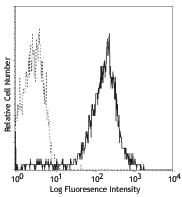

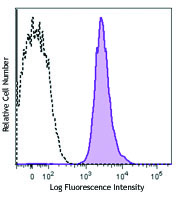
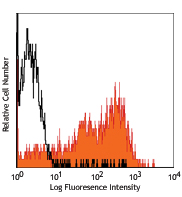
Compare Data Across All Formats
This data display is provided for general comparisons between formats.
Your actual data may vary due to variations in samples, target cells, instruments and their settings, staining conditions, and other factors.
If you need assistance with selecting the best format contact our expert technical support team.
-
Purified anti-human CD49e
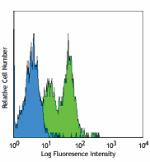
Human peripheral blood lymphocytes stained with purified NKI... -
FITC anti-human CD49e

Human peripheral blood lymphocytes stained with NKI-SAM-1 FI... -
PE anti-human CD49e

Human peripheral blood lymphocytes stained with NKI-Sam-1 PE -
APC anti-human CD49e

Human peripheral blood lymphocytes stained with NKI-SAM1 APC -
Ultra-LEAF™ Purified anti-human CD49e

Human peripheral blood lymphocytes stained with Ultra-LEAF™ ... -
TotalSeq™-C1296 anti-human CD49e
-
TotalSeq™-A1296 anti-human CD49e
 Login / Register
Login / Register 














Follow Us